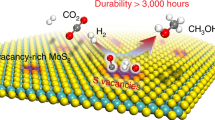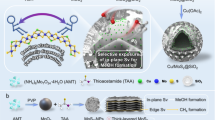Abstract
The conversion of oxygen-rich biomass into hydrocarbon fuels requires efficient hydrodeoxygenation catalysts during the upgrading process. However, traditionally prepared CoMoS2 catalysts, although efficient for hydrodesulfurization, are not appropriate due to their poor activity, sulfur loss and rapid deactivation at elevated temperature. Here, we report the synthesis of MoS2 monolayer sheets decorated with isolated Co atoms that bond covalently to sulfur vacancies on the basal planes that, when compared with conventionally prepared samples, exhibit superior activity, selectivity and stability for the hydrodeoxygenation of 4-methylphenol to toluene. This higher activity allows the reaction temperature to be reduced from the typically used 300 °C to 180 °C and thus allows the catalysis to proceed without sulfur loss and deactivation. Experimental analysis and density functional theory calculations reveal a large number of sites at the interface between the Co and Mo atoms on the MoS2 basal surface and we ascribe the higher activity to the presence of sulfur vacancies that are created local to the observed Co–S–Mo interfacial sites.
This is a preview of subscription content, access via your institution
Access options
Access Nature and 54 other Nature Portfolio journals
Get Nature+, our best-value online-access subscription
$29.99 / 30 days
cancel any time
Subscribe to this journal
Receive 12 print issues and online access
$259.00 per year
only $21.58 per issue
Buy this article
- Purchase on Springer Link
- Instant access to full article PDF
Prices may be subject to local taxes which are calculated during checkout




Similar content being viewed by others
References
Prins, R., De Beer, V. H. J. & Somorjai, G. A. Structure and function of the catalyst and the promoter in Co–Mo hydrodesulfurization catalysts. Catal. Rev. 31, 1–41 (1989).
Grange, P. Catalytic hydrodesulfurization. Catal. Rev. 21, 135–181 (1980).
Byskov, L. S., Nørskov, J. K., Clausen, B. S. & Topsøe, H. DFT calculations of unpromoted and promoted MoS2-based hydrodesulfurization catalysts. J. Catal. 187, 109–122 (1999).
Karunadasa, H. I. et al. A molecular MoS2 edge site mimic for catalytic hydrogen generation. Science 335, 698–702 (2012).
Elliott, D. C. Historical developments in hydroprocessing bio-oils. Energy Fuels 21, 1792–1815 (2007).
Saidi, M. et al. Upgrading of lignin-derived bio-oils by catalytic hydrodeoxygenation. Energy Environ. Sci. 7, 103–129 (2014).
Ruddy, D. A. et al. Recent advances in heterogeneous catalysts for bio-oil upgrading via “ex situ catalytic fast pyrolysis”: catalyst development through the study of model compounds. Green Chem. 16, 454–490 (2014).
Qiao, B. et al. Single-atom catalysis of CO oxidation using Pt1/FeOx . Nat. Chem. 3, 634–641 (2011).
Chen, G. et al. Interfacial effects in iron-nickel hydroxide–platinum nanoparticles enhance catalytic oxidation. Science 344, 495–499 (2014).
Lin, J. et al. Remarkable performance of Ir1/FeOx single-atom catalyst in water gas shift reaction. J. Am. Chem. Soc. 135, 15314–15317 (2013).
Jaramillo, T. F. et al. Identification of active edge sites for electrochemical H2 evolution from MoS2 nanocatalysts. Science 317, 100–102 (2007).
Chhowalla, M. et al. The chemistry of two-dimensional layered transition metal dichalcogenide nanosheets. Nat. Chem. 5, 263–275 (2013).
Cai, L. et al. Vacancy-induced ferromagnetism of MoS2 nanosheets. J. Am. Chem. Soc. 137, 2622–2627 (2015).
Mak, K. F., Lee, C., Hone, J., Shan, J. & Heinz, T. F. Atomically thin MoS2: a new direct-gap semiconductor. Phys. Rev. Lett. 105, 136805 (2010).
Eda, G. et al. Photoluminescence from chemically exfoliated MoS2 . Nano Lett. 11, 5111–5116 (2011).
Eda, G. et al. Coherent atomic and electronic heterostructures of single-layer MoS2 . ACS Nano 6, 7311–7317 (2012).
Makarova, M., Okawa, Y. & Aono, M. Selective adsorption of thiol molecules at sulfur vacancies on MoS2 (0001), followed by vacancy repair via S–C dissociation. J. Phys. Chem. C 116, 22411–22416 (2012).
Yu, Z. et al. Towards intrinsic charge transport in monolayer molybdenum disulfide by defect and interface engineering. Nat. Commun. 5, 5290 (2014).
Chou, S. S. et al. Ligand conjugation of chemically exfoliated MoS2 . J. Am. Chem. Soc. 135, 4584–4587 (2013).
Wang, C., Wu, Z., Tang, C., Li, L. & Wang, D. The effect of nickel content on the hydrodeoxygenation of 4-methylphenol over unsupported NiMoW sulfide catalysts. Catal. Commun. 32, 76–80 (2013).
Whiffen, V. M. L., Smith, K. J. & Straus, S. K. The influence of citric acid on the synthesis and activity of high surface area MoP for the hydrodeoxygenation of 4-methylphenol. Appl. Catal. A 419–420, 111–125 (2012).
Gevert, B. S., Otterstedt, J.-E. & Massoth, F. E. Kinetics of the HDO of methyl-substituted phenols. Appl. Catal. 31, 119–131 (1987).
Wang, W. et al. Influence of surfactants on the synthesis of MoS2 catalysts and their activities in the hydrodeoxygenation of 4-methylphenol. Ind. Eng. Chem. Res. 53, 10301–10309 (2014).
Wang, W. et al. Synthesis of highly active Co–Mo–S unsupported catalysts by a one-step hydrothermal method for p-cresol hydrodeoxygenation. Ind. Eng. Chem. Res. 53, 19001–19009 (2014).
Zhao, C. & Lercher, J. A. Selective hydrodeoxygenation of lignin-derived phenolic monomers and dimers to cycloalkanes on Pd/C and HZSM-5 catalysts. Chem. Cat. Chem. 4, 64–68 (2012).
Liu, G. et al. Hydrazine-assisted liquid exfoliation of MoS2 for catalytic hydrodeoxygenation of 4-methylphenol. Chem. Eur. J. 22, 2910–2914 (2016).
Jia, T. et al. The remarkable activity and stability of a dye-sensitized single molecular layer MoS2 ensemble for photocatalytic hydrogen production. Chem. Commun. 51, 13496–13499 (2015).
Spofford, W. A. & Amma, E. L. Crystal and molecular structure of tetrakisthiourea cobalt (II) nitrate monohydrate, C4H16CoN8S42+,2NO3−,H2O. J. Cryst. Mol. Struct. 6, 235–258 (1976).
Warner, J. H., Rümmeli, M. H., Gemming, T., Büchner, B. & Briggs, G. A. D. Direct imaging of rotational stacking faults in few layer graphene. Nano Lett. 9, 102–106 (2009).
Krivanek, O. L. et al. Atom-by-atom structural and chemical analysis by annular dark-field electron microscopy. Nature 464, 571–574 (2010).
Lin, Y. C. et al. Properties of individual dopant atoms in single-layer MoS2: atomic structure, migration, and enhanced reactivity. Adv. Mater. 26, 2857–2861 (2014).
Zhu, Y. et al. Visualizing the stoichiometry of industrial-style Co–Mo–S catalysts with single-atom sensitivity. Angew Chem. Int. Ed. 53, 10723–10727 (2014).
Le, D., Rawal, T. B. & Rahman, T. S. Single-layer MoS2 with sulfur vacancies: structure and catalytic application. J. Phys. Chem. C 118, 5346–5351 (2014).
Komsa, H. P. & Krasheninnikov, A. V. Native defects in bulk and monolayer MoS2 from first principles. Phys. Rev. B 91, 125304 (2015).
Farias, M. H., Gellman, A. J., Somorjai, G. A., Chianelli, R. R. & Liang, K. S. The CO coadsorption and reactions of sulfur, hydrogen and oxygen on clean and sulfided Mo (100) and on MoS2 (0001) crystal faces. Surf. Sci. 140, 181–196 (1984).
Acknowledgements
We acknowledge financial support from the EPSRC research council, UK. The authors wish to thank the National Synchrotron Radiation Center, Hsinchu, Taiwan (Y.-L. Soo and T.-S. Wu) for access to EXAFS facilities. A.W.R acknowledges financial support from KIER (B6-2452). Y.C.L. and K.S. thank the JST Research Acceleration Programme for support. The authors also acknowledge the use of the UCL Legion High Performance Computing Facilities Legion@UCL and Grace@UCL, and associated support services, in the completion of the theoretical portion of this work. The authors thank the financial support of CSC scholarship to G.L. and Swire scholarship to M.M.-J.L. to work at Oxford University.
Author information
Authors and Affiliations
Contributions
G.L. performed synthesis, catalyst testing and material characterizations; M.M.-J.L. carried out EXAFS analysis; W.C.H.K. carried out HAADF–STEM analysis; A.W.R. and J.H.W. performed AC–TEM analysis; A.W.R., Y.C.L. and K.S. for STEM–EELS analysis; M.T.D., M.H.M. and M.S. for DFT calculations; G.L., A.W.R. and S.C.E.T. wrote the main text; all authors discussed and reviewed this paper. S.C.E.T. planned, supervised and led the project.
Corresponding author
Ethics declarations
Competing interests
The authors declare no competing financial interests.
Supplementary information
Supplementary information
Supplementary information (PDF 2938 kb)
Rights and permissions
About this article
Cite this article
Liu, G., Robertson, A., Li, MJ. et al. MoS2 monolayer catalyst doped with isolated Co atoms for the hydrodeoxygenation reaction. Nature Chem 9, 810–816 (2017). https://doi.org/10.1038/nchem.2740
Received:
Accepted:
Published:
Issue Date:
DOI: https://doi.org/10.1038/nchem.2740
This article is cited by
-
Synthesis and Modulation of Low-Dimensional Transition Metal Chalcogenide Materials via Atomic Substitution
Nano-Micro Letters (2024)
-
Recent advances on liquid intercalation and exfoliation of transition metal dichalcogenides: From fundamentals to applications
Nano Research (2024)
-
Recent advances in machine learning interatomic potentials for cross-scale computational simulation of materials
Science China Materials (2024)
-
Diverse atomic structure configurations of metal-doped transition metal dichalcogenides for enhancing hydrogen evolution
Nano Research (2024)
-
Synergistically enhancing nitrate reduction into N2 in water by N-doped Pd–Cu biochar bimetallic single-atom electrocatalysis
Biochar (2024)



